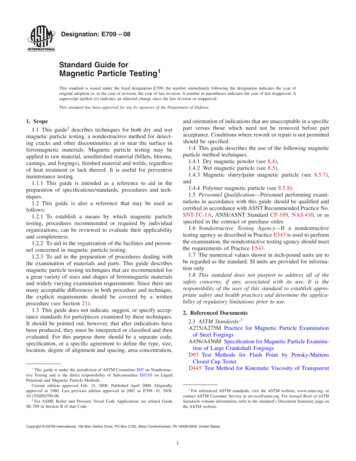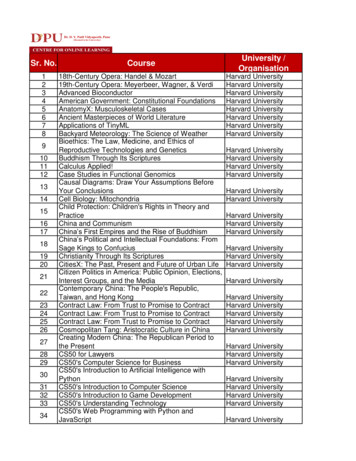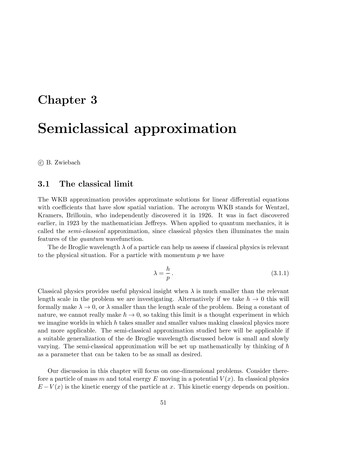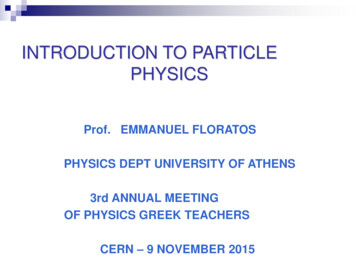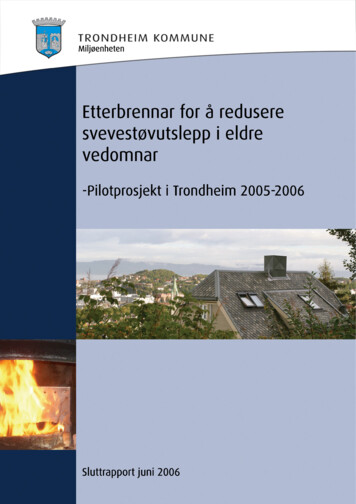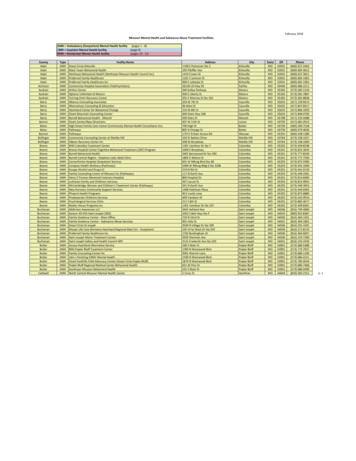
Transcription
Particle PhysicsColumbia Science Honors ProgramWeek 1: IntroductionJanuary 28th, 2017Inês Ochoa, Nevis Labs, Columbia University1
Welcome!José Crespo-Anadón Postdoc on Neutrino group,MicroBooNE experiment at FermilabInês Ochoa Postdoc on ATLASexperiment at CERNCERNFermilab2Cris Vilela Postdoc on T2K and Super-Kexperiments in JapanJ-PARC/Kamioka obs.
Course Policies Attendance: Up to four excused absences(two with notes from parent/guardian)Valid excuses: Illness, family emergency, tests or athletic/academic competitions, mass transit breakdownsInvalid excuses: Sleeping in, missing the trainI will take attendance during class.Please no cell phones. Ask questions :) 3
Schedule1. Introduction2. History of Particle Physics3. Special Relativity4. Quantum Mechanics5. Experimental Methods6. The Standard Model - Overview7. The Standard Model - Limitations8. Neutrino Theory9. Neutrino Experiment10. LHC and Experiments11. The Higgs Boson and Beyond12. Particle Cosmology4
ScheduleInês José Cris1. Introduction 2. History of Particle Physics 3. Special Relativity 4. Quantum Mechanics 5. Experimental Methods6. The Standard Model - Overview7. The Standard Model - Limitations8. Neutrino Theory 9. Neutrino Experiment 10. LHC and Experiments 11. The Higgs Boson and Beyond 12. Particle Cosmology5
6Let’s start from the beginning
What is Particle Physics? Particle physicists explore the most basic components of our natural world: Particles! Not just particles though, also their interactions, and how they become the things wesee around us. This leads us from the littlest things to the the biggest things: from the Big Bang andthe basic constituents of our universe, to its large scale structure, the interiors ofstars and even extra dimensions of space.7
What is Particle Physics? Particle physicists explore the most basic components of our natural world: Particles! Not just particles though, also their interactions, and how they become the things wesee around us. This leads us from the littlest things to the the biggest things: from the Big Bang andthe basic constituents of our universe, to its large scale structure, the interiors ofstars and even extra dimensions of space.Particle physics is a highly developed field:Physicists now want to know more than just what the Universe is made of.The real interesting questions relate to why the Universe is what it is.8
Where did it begin?What is matter made of: 500-300 BCEToday, particle physics is the study of matter,energy, space and time. The Greeks already considered space andtime to be important concepts in theirnatural philosophy.Since the early 20th century, ourunderstanding of space and time hasundergone some profound shifts, becomingever more closely connected to particle physics.It is likely that further dramatic advances willoccur in our lifetime!9This picture of indivisible, solid atomsremained essentially unchanged until 1900!
Rapid progress J.J. ThompsonDiscovering the electron (1897)ATLASDiscovering the Higgs (2012)10
Many experimentsIceCube Neutrino ObservatoryStudying cosmic neutrinos (2010)Planck SatelliteMapping the CMB (2010)11
What is matter made of? Our current model ofmatter consists ofpoint-like particles( 10-18 m), interactingthrough four forces.12
what we are made ofWhat is matter made of? Our current model ofmatter consists ofpoint-like particles( 10-18 m), interactingthrough four forces.13
What is matter made of?Up Quark 0.002 GeVCharm Quark1.25 GeVDown Quark 0.005 GeVStrange Quark 0.095 GeVElectron0.0005 GeVMuon0.105 GeVTop Quark175 GeVBottom Quark4.2 GeVTau1.78 GeVFor reference:Proton0.938 GeVElectronNeutrino 10-9 GeVMuonNeutrino 10-9 GeVTau Neutrino 10-9 GeV14At least two neutrinosneed to be massive.
Adding forces InteractionStrongElectromagneticDescriptionbinds quarks in protonsand neutrons, protons andneutrons in nucleiall extra-nuclear physics(atoms, molecules,chemistry, etc.)MediatorStrengthgluon1photon10-2Weaknuclear β decayW , Z010-7Gravityall types ofparticlesgraviton (?)10-39This picture (excluding gravity) summarizes theStandard Model of particle physics.15
A sense of scale
A sense of scale 17
But this isn’t even half the story The matter described by the Standard Model makes up only 4% ofthe total matter/energy in the Universe. We know almost nothing about the other 96% more on this later.Dark Matter (27%)Ordinarymatter (5%)Dark Energy (68%)18
Many mysteries What is the “dark matter” that makes up a quarter of the universe? What is the “dark energy” that is causing the universe to expand atan increasing rate? Why was there slightly more matter than antimatter in the veryearly universe? Why do particles have the masses that they have?Why is gravity much weaker than the other forces? How do neutrinos fit into the picture?And more 19
20Sources of particles
How can particles be produced? Historically, most elementary particles were discovered by observation of naturalsources: Decays of radioactive elements. Astrophysical sources: coronal mass ejections, extensive air showers, etc.Coronal mass ejection, 1997. LASCO, SOHO.Northern Lights21
How can particles be produced? Historically, most elementary particles were discovered by observation of naturalsources: Decays of radioactive elements. Astrophysical sources: coronal mass ejections, extensive air showers, etc.Supernova remnant; source of ultra-highenergy cosmic rays.Supernovasource ofultra-highCoronal massejection,remnant;1997. LASCO,SOHO.energy cosmic rays.Active Galactic Nuclei22
How can particles be produced? Historically, most elementary particles were discovered by observation of naturalsources:Cosmic rays Decays of radioactive elements. Astrophysical sources: coronal mass ejections, extensive air showers, etc.Supernova remnant; source of ultra-highenergy cosmic rays.Supernovasource ofultra-highCoronal massejection,remnant;1997. LASCO,SOHO.energy cosmic rays.Active Galactic Nuclei23
Cosmic raysCosmic raysSupernova remnant; source of ultra-highenergy cosmic rays.Coronal mass ejection, 1997. LASCO, SOHO.Active Galactic Nuclei24
How can particles be produced? Today, we have sophisticated multi-billion dollar machines thataccelerate and collide particles in finely-tuned beams. Accelerators are expensive, but unlike nature, they provide a precise,controlled testing environment.More on this on a later lecture.Tevatron @ FermilabLHC @ CERN25
26How matter interacts
How matter interacts Elementary particles interact by exerting forces on each other.The mechanism: quarks and leptons exchange “mediator" particles, likephotons, W or Z bosons, and gluons.We depict particle interactions using space-time cartoons called FeynmanDiagrams. Each diagram encodes quantitative physical information about theinteraction.(decay)timeelectromagnetic interaction(photon exchange)strong interaction(gluon exchange/self interaction)27weak interaction(W /Z exchange)
How matter interacts The mediators carry momentum (energy) between two interacting particles,thereby transmitting the force between them.Model of repulsion between two particles: exchangeof the mediator’s momentum.timeelectromagnetic interaction(photon exchange)28
How matter interacts The mediators carry momentum (energy) between two interacting particles,thereby transmitting the force between them.29
How matter interacts The mediators carry momentum (energy) between two interacting particles,thereby transmitting the force between them.30
How matter interacts The mediators carry momentum (energy) between two interacting particles,thereby transmitting the force between them.31
How matter interacts The mediators carry momentum (energy) between two interacting particles,thereby transmitting the force between them.32
How matter interacts The mediators carry momentum (energy) between two interacting particles,thereby transmitting the force between them.33
How matter interacts: the four forces Evidence suggests that all interactions in our universe can be understoodin terms of four fundamental forces: Electromagnetism (photon exchange) Weak interactions (W, Z exchange)The Standard Model Strong interactions (gluon exchange) Gravity (“graviton” exchange? Not yet observed.)This model is phenomenological: we know there are four forces, but wedon’t know why.Current thinking: the four forces are actually different manifestations of asingle field. This field is unified at sufficiently high energies (e.g., right afterthe Big Bang).34
Foundations of Particle Theory Particle physics is the study of the smallest constituents of matter.At these size scales, matter behaves quite differently than in themacroscopic world. Here, particles obey the rules of quantum mechanics. Moreover, to observe the smallest size scales, we must accelerateparticles to very high energies, near the speed of light, c. At thesespeeds, Newtonian mechanics is superseded by special relativity.Elementary particle physics describes objects that are both very small andvery fast.Physicists developed a theoretical framework that incorporates relativisticand quantum principles: Quantum Field Theory.35
Field Theory and the Standard Model Quantum field theory (QFT) is the sophisticated mathematical infrastructure ofparticle physics. It tells us the dynamics of elementary particles - that is, how to use force laws to describe subatomic behavior.While QFT is itself quite challenging, its main product - the Standard Model ofparticle physics - is conceptually straightforward. Some parts of the Standard Model perform incredibly well, for example, QuantumElectrodynamics. Its predictions match experiment with stunning accuracy! Actually, these are the most precise predictions and measurements in Science.μelectron 1.00115965219 0.00000000001μB (measured)μelectron 1.00115965217 0.00000000003μB (QED prediction)(PDG, 2002)36
37Measurement
Measurement Because elementary particles are microscopic - or more correctly, atmost femtoscopic - we must usually resort to indirect observations to seethe fundamental forces at work. Just about all particle physics measurements comefrom the following sources: Scattering: fire particles at each other andmeasure the deflection (e.g. Rutherford experiment)Decays: a particle spontaneously disintegrates,and we observe the debris (e.g. neutron decay,muon decay) Bound states: two or more particles(oppositely charged) form composite objects,whose properties we observe (e.g. atom, nucleus)38From this indirect evidence, wepiece together the dynamics meaning the force laws - obeyedby elementary particles.
Measurement Because elementary particles are microscopic - or more correctly, atmost femtoscopic - we must usually resort to indirect observations to seethe fundamental forces at work. Just about all particle physics measurements comefrom the following sources: Scattering: fire particles at each other andmeasure the deflection (e.g. Rutherford experiment)Decays: a particle spontaneously disintegrates,and we observe the debris (e.g. neutron decay,muon decay) Bound states: two or more particles(oppositely charged) form composite objects,whose properties we observe (e.g. atom, nucleus)39From this indirect evidence, wepiece together the dynamics meaning the force laws - obeyedby elementary particles.
Measurement Because elementary particles are microscopic - or more correctly, atmost femtoscopic - we must usually resort to indirect observations to seethe fundamental forces at work. Just about all particle physics measurements comefrom the following sources: Scattering: fire particles at each other andmeasure the deflection (e.g. Rutherford experiment)Decays: a particle spontaneously disintegrates,and we observe the debris (e.g. neutron decay,muon decay) Bound states: two or more particles(oppositely charged) form composite objects,whose properties we observe (e.g. atom, nucleus)40From this indirect evidence, wepiece together the dynamics meaning the force laws - obeyedby elementary particles.
Scattering example In a scattering experiment, we fire particles at each other and see what happens. Sometimes the particles collide and form new particles according to E mc2(e.g., LHC, Tevatron). Other times, they just deflect (e.g. Rutherford experiment)The amount of deflection can be predicted from a force law.Hence, we can test whether or not we know the force law’s correct form:41
Decay example Inside most nuclei, neutrons are very stable particles. However, free neutrons are unstable; on average, a newly created neutron will lastabout 15 minutes before it breaks into three pieces: a proton, an electron and anelectron anti-neutrino: The weak force is causing the neutron to spontaneously break apart. The nature of the weak force can then be determined by studying the decayproducts and their energies.42
Bound states You are very familiar with bound states: allof the familiar chemical elements are justbound states of nuclei and electrons. When we excite bound states, they emitradiation in particular wavelength bands. Excitation spectrum of hydrogen, abound state of one proton and oneelectron.This radiation contains a wealth ofinformation about the structure of thebound state and the governing force law.Helium, a bound state of two protons,two neutrons, and two electrons, has adifferent excitation spectrum, but isgoverned by the same force law.43
Bound states You are very familiar with bound states: allof the familiar chemical elements are justbound states of nuclei and electrons. When we excite bound states, they emitradiation in particular wavelength bands. This radiation contains a wealth ofinformation about the structure of thebound state and the governing force law.44
Bound states You are very familiar with bound states: allof the familiar chemical elements are justbound states of nuclei and electrons. When we excite bound states, they emitradiation in particular wavelength bands. This radiation contains a wealth ofinformation about the structure of thebound state and the governing force law.45
Atomic excitation An atom is excited when it has the potential to spontaneously produce energy. This happens when one or more of the electrons occupy a higher-energy state. When the electron returns to a lower energy state, the energy difference isgiven off in the form of radiation.The lowest energy state is the ground state.46
Ionization Ion: positively or negatively charged particle (or part of atom)Ions can be produced when enough energy is given to remove one ormore electrons from an atom:eEn 2n 2n 1Ion(free electron)n 1eppionizationIon (free proton)Hydrogen atom (p e bound state)47
Ionization Ion: positively or negatively charged particle (or part of atom)Ions can be produced when enough energy is given to remove one ormore electrons from an atom.Ionization energy is the energy necessary to strip an atom of its mostloosely bound electron (valence electron).48
49Detecting particles
Detecting particlesWhen charged particles pass through matter, they ionize atoms in their path, liberatingcharges, and causing the emission of detectable light (scintillators) or the formation oftracks of droplets (cloud/bubble chambers).This is how we “see” them.Experimental physicists use many kinds of particle detectors, including:- Geiger counters- Cloud chambers *- Bubble chambers *- Spark chambers *- Photographic emulsions *- Wire chambers- Cherenkov counters- Scintillators- Photomultipliers- Calorimeters Note: most are sensitive to electrically charged particles only!50* Less common these days
Measuring particle properties Particle physics tries to identify elementary particles and deduce thequantitative force laws that most simply describe their behavior. A vital force law: Lorentz Force Law, the force on an electric charge qplaced in an electromagnetic field (electric field E and magnetic field B):51
Measuring particle properties Particle physics tries to identify elementary particles and deduce thequantitative force laws that most simply describe their behavior. A vital force law: Lorentz Force Law, the force on an electric charge qplaced in an electromagnetic field (electric field E and magnetic field B):RECALL: A body under the influenceof a force will be deflected from itsoriginal path.F52
Aside: the electric field E You can define the electric field according to what it does to test(electric) charges. The electric field E in a region of space in which a test charge q getsaccelerated by a force F, is given by: In other words, if you put a charge q in an electric field E, that charge willexperience a force proportional to q along the direction of E.53
Aside: the electric field E Every electric charge is also the source of an electric field. According to classical physics, this is how charges attract and repel eachother: each charge detects the field of the other, and then responds accordingto the force law: At the quantum level, this view has been replaced by the model of mediatorexchange, which we flesh out later in the course 54
Measuring particle propertiesA basic particle accelerator: Consider the parallel-plate capacitor Two metal plates are given equal but opposite charges Q and -Q, creating apotential difference V, or drop in voltage, between them.The charges set up a uniform electric field E between the plates.A test charge in this region gets accelerated. This is the principle behind every particle accelerator: pass charges through anelectric field to increase their kinetic energy.55
Energy units: electron-Volts (eV) Basic unit of energy in particle physics: electron-Volt (eV) The eV is the energy acquired by one electron accelerated (in vacuum) through apotential difference of one Volt. Comparison with more familiar units: 1 eV 1.602 x 10-19 Joule Also unit of mass: E mc2 in natural units (c 1): E m And momentum: E pc in natural units (c 1): E pNote: 1 Joule is roughly the energy it takes to lift a 1kg object 10 cm off the ground.56
The magnetic field B According to the Lorentz Force Law, the magnetic force on a charge q is: Note: the magnetic force is perpendicular to both the direction of the field andthe velocity of the (positive) test charge (right-hand rule). If v and B areperpendicular to each other, the charge’s trajectory will bend into a circle. Note: if the charge is stationary (v 0), the magnetic force on it is zero. Magnetic fields only affect moving charges (currents).Note: the direction of the particle’s path depends on the sign ofits charge!57
Measuring particle properties Electric charges moving in uniform magnetic fields travel in circular paths.The path’s radius of curvature yields important information:58
Measuring particle properties Electric charges moving in uniform magnetic fields travel in circular paths. Thepath’s radius of curvature yields important information: By measuring the radius of curvature of a charge’s path, physicists candetermine both the momentum and the sign of the charge. This is the primary means of particle identification inexperiments!59
Recap Particle physics studies the fundamental constituents of the Universe.The Standard Model is the theory that describes the electromagnetic,weak and strong interactions. It has shown incredible prediction power! But leaves some phenomena unexplained Next week: History of Particle Physics
Material Material covered in classes will be available here: in/ScienceHonorsProgram
BonusMagnetic fieldCarl D. Anderson (1932)
Bonus
particle physics. It tells us the dynamics of elementary particles - that is, how to use force laws to describe subatomic behavior. While QFT is itself quite challenging, its main product - the Standard Model of particle physics - is conceptually straightforward. Some parts of the Sta
